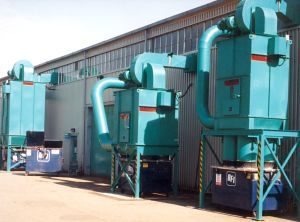 Four tips for sizing dust collection systems
Four tips for sizing dust collection systems
May 1, 2017 REDWIRE is news you can use from leading suppliers. Powered by FRASERS.
Posted by N.R. Murphy Limited
Since 1943, we have Experience In Custom Manufacturing Dust Collection Systems And Related Equipment. Also Includes: Cus... Read more
Subscribe
Free REDWIRE e-newsletter

N.R. Murphy Limited manufactures a comprehensive line of dust collecting equipment. That includes dust collectors, filters, fans and accessories used for diverse applications in agriculture, chemical, mining, printing and more. The company can also provide dust collection systems of all sizes, ranging from small units for individual machines to large collectors for many applications.
When it comes to designing or selecting a dust collection system that is properly suited to the application, there are many factors to take into consideration, particularly when it comes to determining the right system size and configuration. This is a topic that N.R. Murphy covered a number of years ago in an article, but these tips still hold true today.
1. Make a list of dust-producing equipment.
The first step is to make a list of equipment that produces dust and a scaled drawing that identifies the locations of machines in the plant. This information can then be used to determine the total volume of air required for the system. That involves taking the square-footage of all the pickup points and multiplying it by the velocity needed to keep material in suspension in the ductwork. When determining this number, the weight and flow characteristics of the material must be considered.
2. Determine the dust collector location
When choosing where to position the dust collector, important factors include accessibility for installation, as well as waste disposal vehicles. Another key consideration is whether the collector will be placed inside or outside. National fire codes limit the size of collectors that can be installed inside plants without additional measures for explosion venting, so be sure to check with local authorities. Once a location is chosen, the scaled drawing can be used to design the ducting layout, size the branch lines and main duct, and determine the static pressure of the total system.
3. Determine the filter area required
Based on the material being collected and the dust collector’s duty cycle, the appropriate air-to-cloth ratio can be selected. For instance, continuous-cleaning style dust collectors are typically capable of operating non-stop at higher air-to-cloth ratios when compared to shaker-style collectors.
4. Deal with a reputable company
While these basic steps are useful for managers and shop owners, the actual design and selection process should be handled by an experienced professional designer or engineer. This expertise is available at N.R. Murphy Limited. Visit the company’s website for more information.
Share
Posted by N.R. Murphy Limited
Since 1943, we have Experience In Custom Manufacturing Dust Collection Systems And Related Equipment. Also Includes: Cus... Read more
